Vitiligo Treatment Market Size
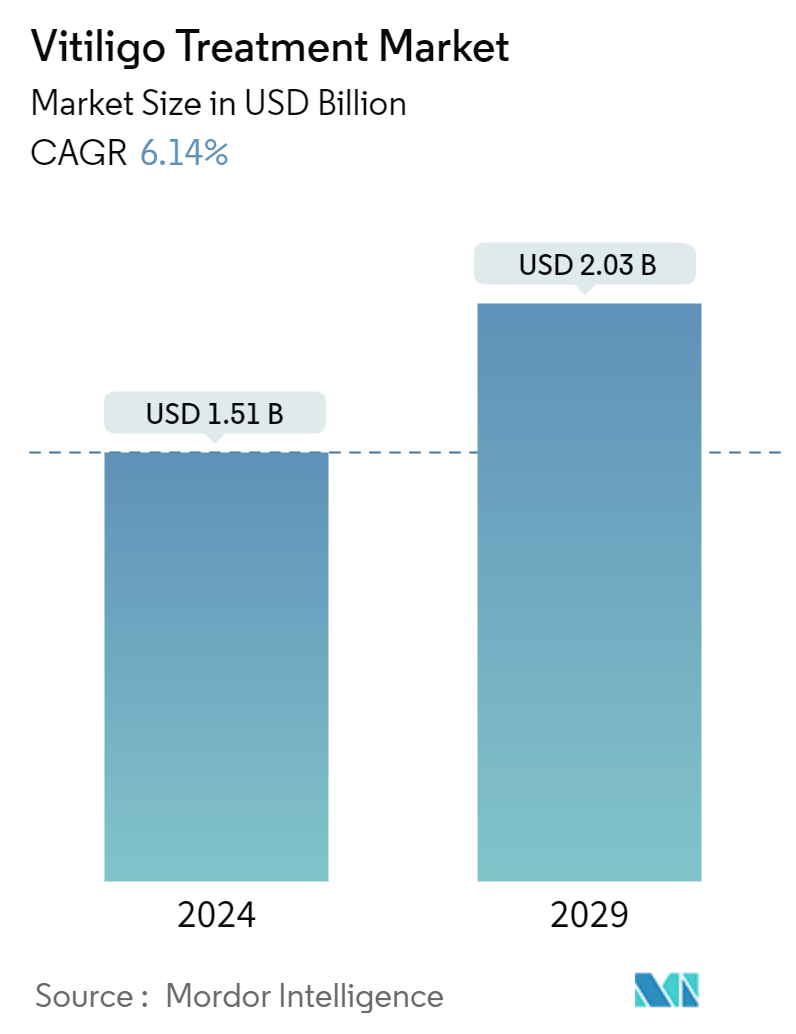
| Study Period | 2019 - 2029 |
| Market Size (2024) | USD 1.51 Billion |
| Market Size (2029) | USD 2.03 Billion |
| CAGR (2024 - 2029) | 6.14 % |
| Fastest Growing Market | Asia Pacific |
| Largest Market | North America |
Major Players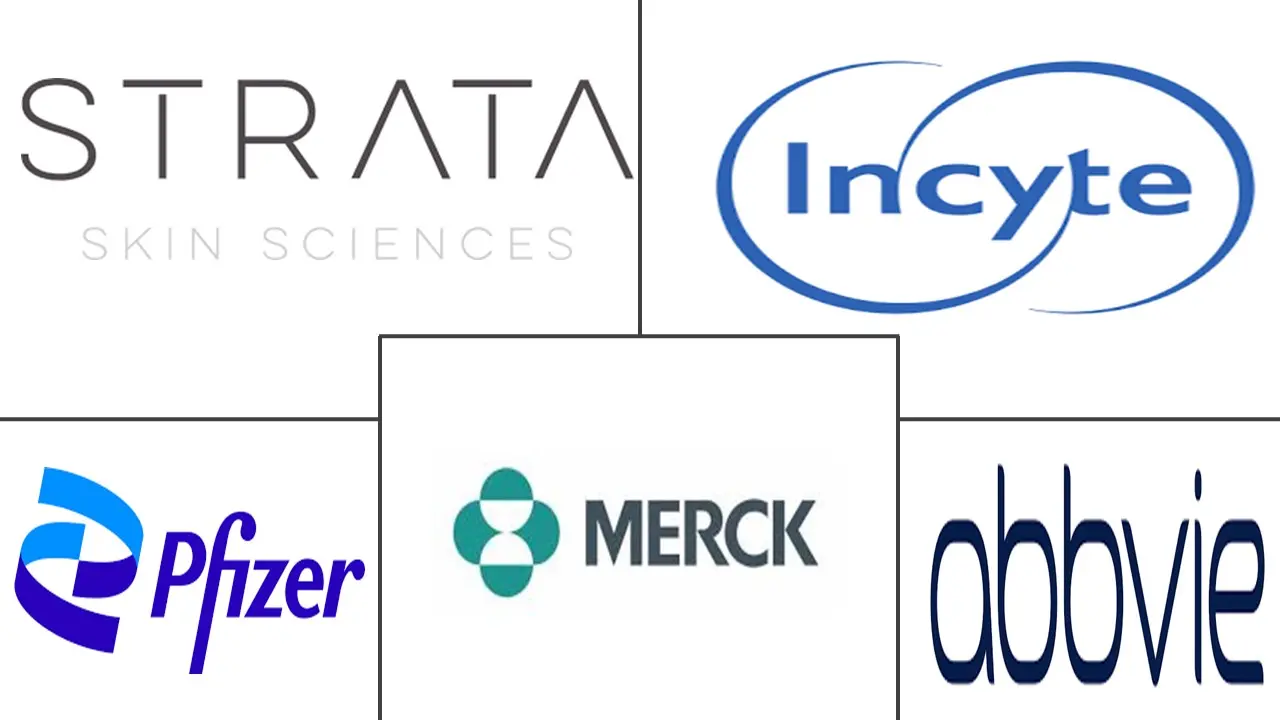
*Disclaimer: Major Players sorted in no particular order |
Vitiligo Treatment Market Analysis
The Vitiligo Treatment Market size is estimated at USD 1.51 billion in 2024, and is expected to reach USD 2.03 billion by 2029, growing at a CAGR of 6.14% during the forecast period (2024-2029).
The surge in the prevalence of vitiligo is primarily driving the market’s growth. According to data from the Global Vitiligo Foundation 2024, 70 million people worldwide have vitiligo. With more people being diagnosed, the need for diverse and influential treatment options has become more pressing. Patients and healthcare providers seek therapies to manage the condition, restore pigmentation, and improve quality of life. This has led to a growing market for topical treatments, light therapies, and emerging approaches like biologics and immunomodulatory drugs.
Additionally, rising research into the diagnosis of vitiligo positively impacts the market by enhancing the understanding of the disease’s mechanisms and improving diagnostic precision. In June 2023, UMass Chan Medical School researchers launched a clinical study backed by the National Institute of Allergy and Infectious Diseases funding. The study aimed to pinpoint the biological and molecular markers that might make specific individuals more susceptible to vitiligo. Over the next five years, the team aims to enroll approximately 1,000 participants, all of whom will be engaged remotely. Out of the 1,000, they expect 200 to have a confirmed vitiligo diagnosis, with the rest being family members or direct blood relatives of those diagnosed. Such trials empower scientists to forecast disease onset, track its progression, and anticipate relapses.
Rising awareness and diagnosis are pivotal drivers in the vitiligo treatment market, significantly contributing to its growth. As more people become informed about vitiligo, its symptoms, and available treatment options, the number of individuals seeking medical advice and diagnosis has risen. Several foundations and pharmaceutical companies have launched initiatives to promote awareness. For instance, in September 2023, Incyte Corporation launched an educational initiative to promote awareness about vitiligo. This included webinars, workshops for healthcare professionals, and patient-focused educational content aimed at improving early diagnosis and access to treatment options. In July 2022, the National Institute of Arthritis and Musculoskeletal and Skin Diseases (NIAMS) initiated an awareness campaign about vitiligo for the public and healthcare providers. This initiative distributed informational materials and resources to promote early diagnosis and intervention.
Advancements in R&D have allowed a better understanding of the underlying mechanisms of vitiligo, particularly the autoimmune processes that contribute to destroying melanocytes, the cells responsible for skin pigmentation. This has paved the way for the development of targeted treatments, including novel drugs and biologics that offer more effective and personalized care for patients. For instance, in June 2023, Clinuvel Pharmaceuticals announced the initiation of Phase II clinical trials for a new photoprotective drug to prevent further depigmentation in vitiligo patients.
The vitiligo treatment market is influenced by diverse factors that drive its expansion and development. Increasing awareness and diagnosis, advancements in research and technology, growing cosmetic and psychological concerns, rising disposable incomes, and government support all contribute to the market’s growth. As these driving forces continue to evolve, they will likely shape the future of vitiligo treatment and improve the quality of life for individuals affected by this condition. Despite these advancements, challenges such as high treatment costs and the absence of standardized protocols hinder market growth.
Vitiligo Treatment Market Trends
The Non-segmental Vitiligo Segment is Expected to Witness Significant Growth Over the Forecast Period
Generalized vitiligo, commonly referred to as non-segmental vitiligo, is the predominant type of vitiligo. It is marked by a symmetrical and widespread loss of skin pigmentation in multiple areas of the body. This type of vitiligo affects approximately 90% of those with the condition and is marked by the gradual development of white patches on both sides of the body. The non-segmental vitiligo segment is driven by a range of factors, including increasing prevalence, advancements in treatment options, and heightened awareness about the condition.
Recent advancements in treatment options for non-segmental vitiligo have significantly impacted the segment. Historically, treatment options were limited to topical corticosteroids, phototherapy, and surgical interventions. However, recent developments have introduced new therapies with better efficacy and fewer side effects. For example, the approval of Janus kinase (JAK) inhibitors, such as Incyte Corporation’s Opzelura (ruxolitinib cream) in 2022, provided a novel and effective treatment option. Such new therapies offer targeted approaches that address the underlying autoimmune mechanisms of vitiligo, improving treatment outcomes and expanding the market.
In addition, continuous research and development (R&D) efforts are crucial drivers of the segment. Pharmaceutical companies and research institutions are actively exploring new treatment modalities, including biologics, gene therapies, and combination treatments. For instance, Vyne Therapeutics developed VYN201, a locally administered pan-BD BET (bromodomain and extra-terminal) inhibitor. In May 2024, the company initiated a phase-II clinical trial to showcase its efficacy in managing non-segmental vitiligo.
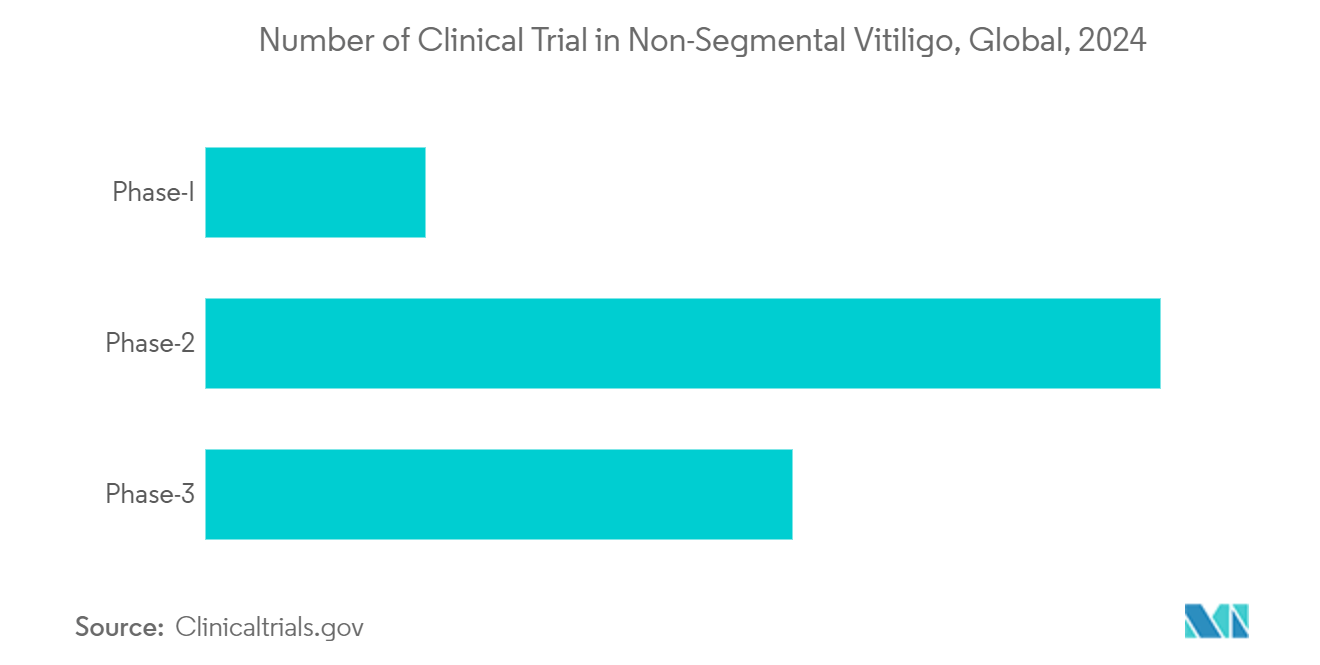
North America is Expected to Dominate the Vitiligo Treatment Market
The North American vitiligo treatment market is one of the most advanced and rapidly growing globally. This growth is fueled by increasing awareness, a high prevalence of the condition, substantial healthcare spending, and persistent research and development (R&D) endeavors. The region's robust healthcare infrastructure and access to cutting-edge treatments have made it a focal point for innovation and market expansion in vitiligo therapies.
One of the most significant drivers of the vitiligo treatment market in North America is the increasing prevalence of the condition. Data from the National Institute of Arthritis and Musculoskeletal and Skin Diseases (NIAMS) in 2022 indicated that vitiligo impacted roughly 2 to 5 million individuals in the United States. The Canadian Dermatology Association in 2024 noted that about 0.5% to 2% of Canada's general populace was affected. While vitiligo can affect individuals of any race or gender, its visibility is often more pronounced in those with darker skin tones. As awareness of vitiligo rises, more individuals are seeking medical consultations and exploring treatment options. This increased medical attention has led to a higher diagnosis rate, which, in turn, is propelling market growth.
North America, particularly the United States, is a hub for R&D activities in vitiligo treatment, with numerous ongoing clinical trials and research initiatives. The region's pharmaceutical companies are at the forefront of developing novel therapies, such as JAK inhibitors, biologics, and gene therapies, expected to drive market growth in the coming years. For instance, in September 2023, Clinuvel Pharmaceuticals announced its expansion into the North American market, focusing on vitiligo treatments. The company is known for its innovative approach to managing skin pigmentation disorders and plans to introduce its photoprotective therapies to the US market. Additionally, in February 2023, Edesa Biotech received the green light from Health Canada for a Phase II clinical trial of its EB06 monoclonal antibody candidate targeting vitiligo. Such trials play a pivotal role in evaluating new treatments, spotlighting innovative drugs and therapies with the potential to restore skin pigmentation and curb disease progression.
The North American vitiligo treatment market showcases a pronounced inclination toward advanced therapies, spanning biologics, topical solutions, and phototherapy. Bolstered by substantial R&D investments from pharmaceutical giants, the region is actively crafting novel treatment modalities to meet the pressing needs of vitiligo patients, propelling the market's growth trajectory.
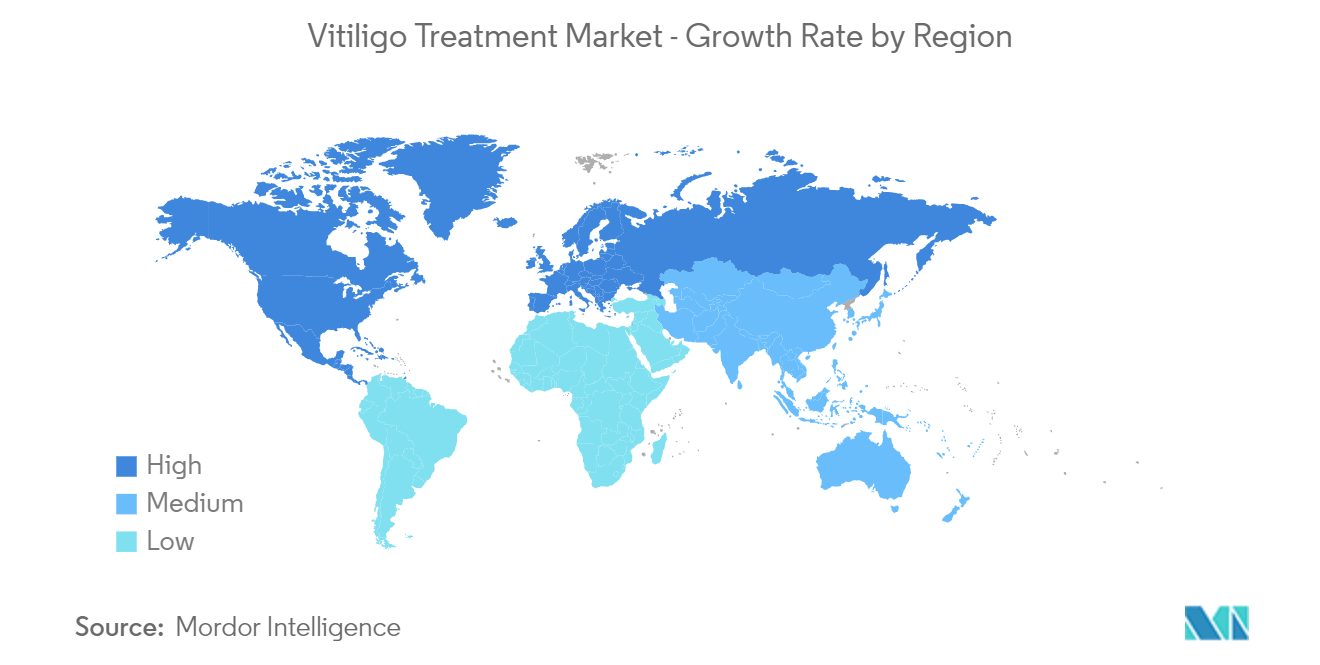
Vitiligo Treatment Industry Overview
The vitiligo treatment market is fragmented due to the presence of a few companies operating globally and regionally. The competitive landscape includes an analysis of a few international as well as local companies that hold significant market shares, such as AbbVie Inc., Ahammune Biosciences, Almirall SA, Astellas Pharma Inc., Dr. Reddy's Laboratories, Edesa Biotech, Incyte Corporation, Merck & Co. Inc., Pfizer Inc., and STRATA Skin Sciences.
Vitiligo Treatment Market Leaders
-
Incyte
-
AbbVie Inc.
-
Pfizer Inc.
-
Almirall, S.A.
-
STRATA Skin Sciences
*Disclaimer: Major Players sorted in no particular order
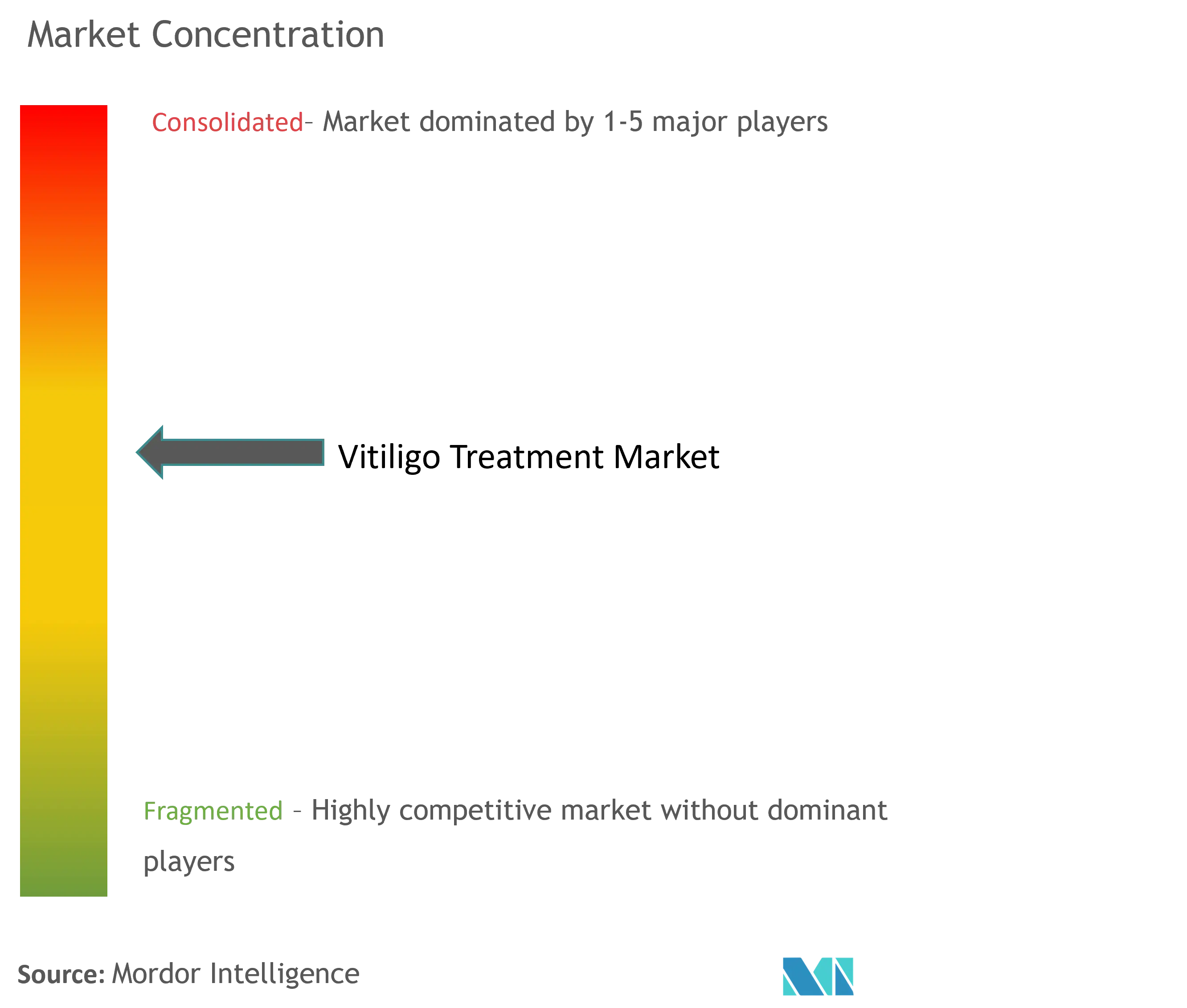
Vitiligo Treatment Market News
- February 2023: Pfizer announced a collaboration with Arvinas, a clinical-stage biotechnology company, to explore the development of protein degradation therapies for autoimmune diseases, including vitiligo.
- June 2022: Ahammune Biosciences partnered with Veeda Clinical Research to initiate first-in-human studies evaluating AB1001, a topical therapy for the management of vitiligo.
Vitiligo Treatment Market Report - Table of Contents
1. INTRODUCTION
- 1.1 Study Assumptions and Market Definition
- 1.2 Scope of the Study
2. RESEARCH METHODOLOGY
3. EXECUTIVE SUMMARY
4. MARKET DYNAMICS
- 4.1 Market Overview
-
4.2 Market Drivers
- 4.2.1 Rising Prevalence of Vitiligo and Increasing Awareness
- 4.2.2 Growing R&D Activities
-
4.3 Market Restraints
- 4.3.1 Lack of Standardized Treatments
-
4.4 Porter's Five Force Analysis
- 4.4.1 Threat of New Entrants
- 4.4.2 Bargaining Power of Buyers/Consumers
- 4.4.3 Bargaining Power of Suppliers
- 4.4.4 Threat of Substitute Products
- 4.4.5 Intensity of Competitive Rivalry
5. MARKET SEGMENTATION (Market Size by Value - USD)
-
5.1 By Disease Type
- 5.1.1 Non-segmental Vitiligo
- 5.1.2 Segmental Vitiligo
-
5.2 By Therapy
- 5.2.1 Topical Treatment
- 5.2.2 Light Therapy
- 5.2.3 Surgical Procedures
- 5.2.4 Others
-
5.3 By End User
- 5.3.1 Hospitals
- 5.3.2 Aesthetic Clinics
- 5.3.3 Others
-
5.4 Geography
- 5.4.1 North America
- 5.4.1.1 United States
- 5.4.1.2 Canada
- 5.4.1.3 Mexico
- 5.4.2 Europe
- 5.4.2.1 Germany
- 5.4.2.2 United Kingdom
- 5.4.2.3 France
- 5.4.2.4 Italy
- 5.4.2.5 Spain
- 5.4.2.6 Rest of Europe
- 5.4.3 Asia-Pacific
- 5.4.3.1 China
- 5.4.3.2 Japan
- 5.4.3.3 India
- 5.4.3.4 Australia
- 5.4.3.5 South Korea
- 5.4.3.6 Rest of Asia-Pacific
- 5.4.4 Middle East and Africa
- 5.4.4.1 GCC
- 5.4.4.2 South Africa
- 5.4.4.3 Rest of Middle East and Africa
- 5.4.5 South America
- 5.4.5.1 Brazil
- 5.4.5.2 Argentina
- 5.4.5.3 Rest of South America
6. COMPETITIVE LANDSCAPE
-
6.1 Company Profiles
- 6.1.1 AbbVie Inc.
- 6.1.2 Ahammune Biosciences
- 6.1.3 Almirall, S.A.
- 6.1.4 Astellas Pharma Inc.
- 6.1.5 Dr. Reddy's Laboratories
- 6.1.6 Edesa Biotech
- 6.1.7 Incyte Corporation
- 6.1.8 Merck & Co. Inc
- 6.1.9 Pfizer Inc.
- 6.1.10 STRATA Skin Sciences
- *List Not Exhaustive
7. MARKET OPPORTUNITIES AND FUTURE TRENDS
** Subject To AvailablityVitiligo Treatment Industry Segmentation
Vitiligo is a chronic skin condition characterized by the loss of pigment-producing cells called melanocytes, leading to the development of white patches on the skin. These patches can appear anywhere on the body, including the face, hands, and other areas exposed to the sun, as well as in the mucous membranes and the retina of the eyes.
The vitiligo treatment market is segmented by disease type (non-segmental vitiligo and segmental vitiligo), therapy (topical treatment, light therapy, surgical procedures, and others), end user (hospital, aesthetic clinics, and others), and geography (North America, Europe, Asia-Pacific, Middle East and Africa, and South America). The report offers the value (USD) for all the above segments.
Vitiligo Treatment Market Research FAQs
How big is the Vitiligo Treatment Market?
The Vitiligo Treatment Market size is expected to reach USD 1.51 billion in 2024 and grow at a CAGR of 6.14% to reach USD 2.03 billion by 2029.
What is the current Vitiligo Treatment Market size?
In 2024, the Vitiligo Treatment Market size is expected to reach USD 1.51 billion.
Who are the key players in Vitiligo Treatment Market?
Incyte, AbbVie Inc., Pfizer Inc., Almirall, S.A. and STRATA Skin Sciences are the major companies operating in the Vitiligo Treatment Market.
Which is the fastest growing region in Vitiligo Treatment Market?
Asia Pacific is estimated to grow at the highest CAGR over the forecast period (2024-2029).
Which region has the biggest share in Vitiligo Treatment Market?
In 2024, the North America accounts for the largest market share in Vitiligo Treatment Market.
What years does this Vitiligo Treatment Market cover, and what was the market size in 2023?
In 2023, the Vitiligo Treatment Market size was estimated at USD 1.42 billion. The report covers the Vitiligo Treatment Market historical market size for years: 2019, 2020, 2021, 2022 and 2023. The report also forecasts the Vitiligo Treatment Market size for years: 2024, 2025, 2026, 2027, 2028 and 2029.
Vitiligo Treatment Industry Report
Statistics for the 2024 Vitiligo Treatment market share, size and revenue growth rate, created by Mordor Intelligence™ Industry Reports. Vitiligo Treatment analysis includes a market forecast outlook for 2024 to 2029 and historical overview. Get a sample of this industry analysis as a free report PDF download.



